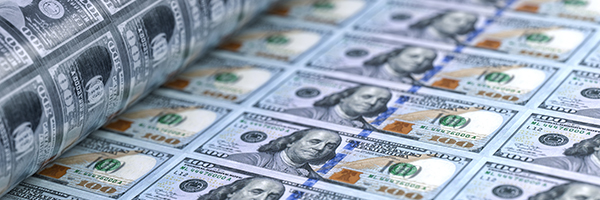GLD

February 19, 2025 | Daily JAM, GDX, GDXJ, GLD, GOLD, Jubak Picks, Morning Briefing, NEM, Perfect Five-ETFs, Volatility |
Today Goldman Sachs Group raised its year-end target for gold to $3,100 an ounce. Central banks are buying gold at a faster than expected pace and flows into gold ETFs are accelerating.

February 14, 2025 | AAPL, ACAD, AGN, ALV, AMZN, AUY, BABA, BG, BGC, BHP, BMY, CHK, CMI, CNI, COH, CSCO, CX, Daily JAM, DD, DE, DHR, DXJR, EBAY, ENB, EUM, FB, FCX, FLR, FLS, FTV, GLD, Jubak Picks, MPC, OGXI, OKS, PEP, PFXF, POT, PXD, QCOM, RSPP, RYN, SDRL, SFTBY, SH, SLB, SPWR, Videos, Volatility |
Today’s Hot Money Moves NOW is China Buys More Gold. Gold seems like a good asset to own right now but it’s also trading at record highs. So while gold is safe, especially if inflation goes up, how much higher do you expect gold to go? One thing to look at it is who is emerging as a buyer. Central banks have been buying gold to hedge risks and diversify, which has contributed to the record highs. Recently, the Chinese government announced that 10 big Chinese insurance companies will now be allowed to put up to 1% of their portfolios into gold. This hasn’t been allowed in the past and will provide about $27 billion for new gold buying. This is also just another sign that countries and businesses are looking to hedge risk by buying gold and it’s one of the safer places to be in an uncertain market.

February 8, 2025 | Daily JAM, GLD, Jubak Picks, Videos, Volatility |
Today’s Hot Money Moves NOW is “Gold via 747.” It is extraordinary when big New York banks like Goldman Sachs have hired 747s to fly physical gold from London (where it’s cheaper) to New York. Most investors don’t own a 747 and may not be able to do this trade, but it is indicative of the high degree of uncertainty in the market. Flying gold from London to New York is a truly extreme move, and you wouldn’t see that without an underlying fundamental stress in the market. Gold is trading near all-time highs and you may not make a whole lot of money buying gold ETFs from here, but you would be avoiding some risk in the rest of the market. I have the GLD ETF in my Jubak Picks portfolio and will likely look for another to add.

January 10, 2025 | AAPL, ACAD, ADSK, AGN, ALB, ALV, AMZN, ARCO, ARGT, AUY, BABA, BG, BGC, BHP, BMY, CHK, CMI, CNI, COH, CSCO, CTRP, CX, Daily JAM, DD, DE, DHR, DWDP, DXJR, EBAY, EEM, EFNL, ENB, EUM, EWZS, FANG, FANUY, FB, FCX, FEZ, FLR, FLS, FTV, GDXJ, GE, GGAL, GLD, GLW, GOOG, HAIN, HDB, HP, INCY, ING, IONS, ITUB, IVV, JCI, JO, JOY, KBWB, KMI, LFL, LNG, LUX, MGM, MIDD, MON, Morning Briefing, MPC, MXF, NJDCY, NKTR, OGXI, OKS, PEP, PFXF, POT, PXD, PYPL, QCOM, RSPP, RYN, SDRL, SFTBY, SH, SLB, SPWR, SQM, STO, SYNA, TCEHY, TPR, TRGP, TS, V, VALE, VEA, Videos, VMC, VZ, WBK, WES, XOM, XYL, YPF, Z-SYMBOLS |
In December U.S. economy in December added the most jobs since March and the unemployment rate unexpectedly fell. Nonfarm payrolls increased 256,000, exceeding all but one forecast in a Bloomberg survey of economists. The unemployment rate fell to 4.1%, while average hourly earnings rose 0.3% from November, a Bureau of Labor Statistics report showed Friday. For 2024 as a whole, the economy added 2.2 million jobs—-below the 3 million increase in 2023 but above the 2 million created in 2019. The data almost certainly assured that the Federal Reserve would not cut interest rates at its January 29 meeting. As of 11 a.m. New York time, the yield on the 10-year Treasury had climbed another 5 basis points to 4.74%.

January 9, 2025 | AAPL, ACAD, ADSK, AGN, ALB, ALV, AMZN, ARCO, ARGT, AUY, BABA, BG, BGC, BHP, BMY, CHK, CMI, CNI, COH, CSCO, CTRP, CX, DD, DE, DHR, DWDP, DXJR, EBAY, EEM, EFNL, ENB, EUM, EWZS, FANG, FANUY, FB, FCX, FEZ, FLR, FLS, FTV, GDXJ, GE, GGAL, GLD, GLW, GOOG, HAIN, HDB, HP, INCY, ING, IONS, ITUB, IVV, JCI, JO, JOY, KBWB, KMI, LFL, LNG, LUX, MGM, Mid Term, MIDD, MON, Morning Briefing, MPC, MXF, NJDCY, NKTR, Notes You Need, OGXI, OKS, PEP, Perfect Five-ETFs, PFXF, POT, PXD, PYPL, QCOM, RSPP, RYN, SDRL, SFTBY, SH, SLB, SPWR, SQM, STO, SYNA, TCEHY, TPR, TRGP, TS, V, VALE, VEA, Videos, VMC, VZ, WBK, WES, XOM, XYL, YPF, Z-SYMBOLS |
China’s consumer price index rose 0.1% in December from a year earlier, in line with the median forecast of economists surveyed by Bloomberg. Factory deflation extended into a 27th month, though the producer price index recorded a slower drop of 2.3%, the National Bureau of Statistics said Thursday. For the full year, consumer prices only inched up 0.2% from 2023, well short of the 1.1% gain economists had predicted at the beginning of 2024.

January 8, 2025 | AAPL, ACAD, ADSK, AGN, ALB, ALV, AMZN, ARCO, ARGT, AUY, BABA, BG, BGC, BHP, BMY, CHK, CMI, CNI, COH, CSCO, CTRP, CX, DD, DE, DHR, DWDP, DXJR, EBAY, EEM, EFNL, ENB, EUM, EWZS, FANG, FANUY, FB, FCX, FEZ, FLR, FLS, FTV, GDXJ, GE, GGAL, GLD, GLW, GOOG, HAIN, HDB, HP, INCY, ING, IONS, ITUB, IVV, JCI, JO, JOY, KBWB, KMI, LFL, LNG, LUX, MGM, MIDD, MON, Morning Briefing, MPC, MXF, NJDCY, NKTR, Notes You Need, OGXI, OKS, PEP, PFXF, POT, PXD, PYPL, QCOM, RSPP, RYN, SDRL, SFTBY, SH, Short Term, SLB, SPWR, SQM, STO, SYNA, TCEHY, TPR, TRGP, TS, V, VALE, VEA, Videos, VMC, VZ, WBK, WES, XOM, XYL, YPF, Z-SYMBOLS |
In minutes from the Federal Reserve’s December 17-18 meeting released on Wednesday, January 8, Federal Reserve officials clearly decided to move more slowly on cutting interest rates in the quarters ahead. “Participants indicated that the committee was at or near the point at which it would be appropriate to slow the pace of policy easing,” minutes from the Federal Open Market Committee showed. “Many participants suggested that a variety of factors underlined the need for a careful approach to monetary policy decisions over coming quarters.” Please note the reference to “quarters” and not “months.”

January 8, 2025 | AAPL, ACAD, ADSK, AGN, ALB, ALV, AMZN, ARCO, ARGT, AUY, BABA, BG, BGC, BHP, BMY, CHK, CMI, CNI, COH, CSCO, CTRP, CX, DD, DE, DHR, DWDP, DXJR, EBAY, EEM, EFNL, ENB, EUM, EWZS, FANG, FANUY, FB, FCX, FEZ, FLR, FLS, FTV, GDXJ, GE, GGAL, GLD, GLW, GOOG, HAIN, HDB, HP, INCY, ING, IONS, ITUB, IVV, JCI, JO, JOY, KBWB, KMI, LFL, LNG, LUX, MGM, MIDD, MON, Morning Briefing, MPC, MXF, NJDCY, NKTR, Notes You Need, OGXI, OKS, PEP, Perfect Five-ETFs, PFXF, POT, PXD, PYPL, QCOM, RSPP, RYN, SDRL, SFTBY, SH, Short Term, SLB, SPWR, SQM, STO, SYNA, TCEHY, TPR, TRGP, TS, V, VALE, VEA, Videos, VMC, VZ, WBK, WES, XOM, XYL, YPF, Z-SYMBOLS |
The 20-year Treasury bond, a laggard on the government debt curve since its re-introduction in 2020, topped 5% Wednesday for the first time since 2023. The move looks to be fueled by concern that President-elect Donald Trump’s policies on tariffs and tax cuts will lead to wider deficits and rekindle inflation.

January 7, 2025 | AAPL, ACAD, ADSK, AGN, ALB, ALV, AMZN, ARCO, ARGT, AUY, BABA, BG, BGC, BHP, BMY, CHK, CMI, CNI, COH, CSCO, CTRP, CX, Daily JAM, DD, DE, DHR, DWDP, DXJR, EBAY, EEM, EFNL, ENB, EUM, EWZS, FANG, FANUY, FB, FCX, FEZ, FLR, FLS, FTV, GDXJ, GE, GGAL, GLD, GLW, GOOG, HAIN, HDB, HP, INCY, ING, IONS, ITUB, IVV, JCI, JO, JOY, KBWB, KMI, LFL, LNG, LUX, MGM, Mid Term, MIDD, MON, Morning Briefing, MPC, MXF, NJDCY, NKTR, OGXI, OKS, PEP, PFXF, POT, PXD, PYPL, QCOM, RSPP, RYN, SDRL, SFTBY, SH, SLB, SPWR, SQM, STO, SYNA, TCEHY, TPR, TRGP, TS, V, VALE, VEA, Videos, VMC, VZ, WBK, WES, XOM, XYL, YPF, Z-SYMBOLS |
The Institute for Supply Management’s index of services advanced 2 points to 54.1 last month. That show of strength in the economy–readings above 50 indicate expansion–was enough to push stocks lower as the markets began to price in a delay in the next interest rate cut from the Federal Reserve until July The measure of prices paid for materials and services rose more than 6 points to 64.4, suggesting that the drop in the inflation rate in the service sector–about 70% of the U.S. economy–might be over.

November 19, 2024 | Daily JAM, Dividend Income, GLD, GOLD, Mid Term, NEM, Special Reports, VZ |
If you’re an investor looking for income, you’re facing what I’d call a Yield Drought. And this is no temporary dry spell. Things on the income investing front look they’ll get worse before they get better. Unless a financial crisis intervenes in 2025 to make everything else much worse and the yield story much better. Because, you see, there are two parts to the current Yield Drought.

November 19, 2024 | Daily JAM, GLD, GOLD, Morning Briefing, NEM, Short Term |
Gold will rally to a record next year on central-bank buying and U.S. interest rate cuts, according to Goldman Sachs. The investment bank listed the metal among top commodity trades for 2025. “Go for gold,” analysts said in a note, reiterating a target of $3,000 an ounce by December 2025.

September 17, 2024 | Daily JAM, GLD, GOLD, Jubak Picks, Perfect Five-ETFs, Short Term, Volatility |
I think you want to own gold–through something like the SPDR Gold Shares ETF (GLD) right now to profit from decreasing interest rates at most of the world’s central banks, from global macro uncertainty, from the possibility of domestic violence in the United States around the election, and from what sure looks like a train wreck in U.S. fiscal policy.
In the short term. Say six to nine months–maybe even a year–from now. The SPDR Gold Shares ETF is up 24.84% for 2024 as of the September 16 close. In that same time period I think shares of gold mining companies are likely to lag the gains in gold. Shares of Barrack Gold (GOLD), the world’s second largest gold producer, are up just 15.09% in 2024.

August 26, 2024 | Daily JAM, GDX, GLD, GOLD, Jubak Picks, Mid Term, Morning Briefing, NEM, Perfect Five-ETFs, Stock Alerts, Volatility |
Gold hit a new all-time high today of $2554 an ounce on the Comex for December delivery. Gold’s 20% or so gain in 2024 to date (as of August 26) is a result of strong central-bank buying plus Asian purchases plus anticipation that the Federal Reserve was about to cut interest rates. Now that Fed chair Jerome Powell has just about promised a cut at the Fed’s September 18 meeting it looks like gold will climb further in 2024 on the fundamentals. Bullish Wall Street targets say $2700 to $3,000 by the end of 2024. That’s a decent reason to hold gold. But the very scary geopolitical landscape over the next six months makes me anxious to add more gold even at the record nominal high for the metal.













